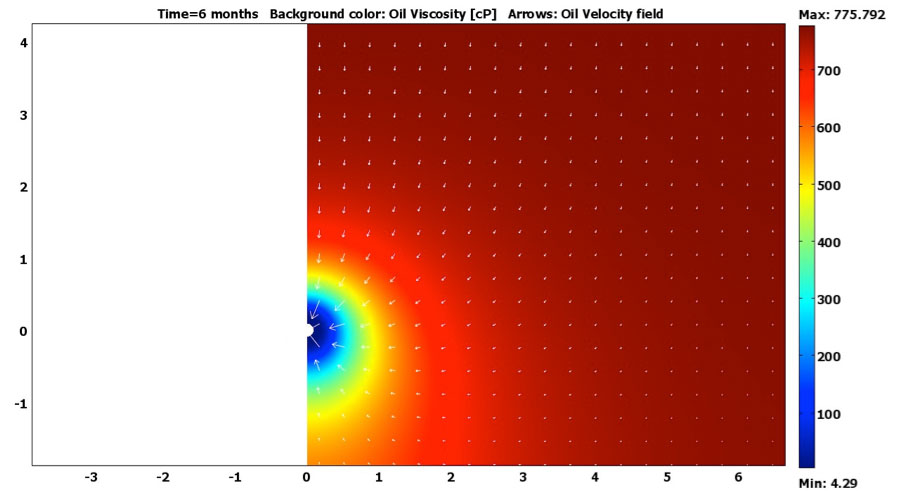Hot pipes set me free! Tar sands, heavy oil, paraffin — three killers of mature fields. Finally, a simple and effective solution — hot pipes! It's a great concept, but does it work? Here's a continuation of an interview with Dr. Richard Snow, Pyrophase, who answers questions about their technology that helps stimulate flow in wells with paraffin or low-gravity oil problems.
Does the pipe heat up? How much?
We program the PyroHeater to hold the pipe to a set temperature. For heavy oil reservoir treatment we have used 200 oC. For paraffin treatment 140 oF or 60 oC is considered enough to keep paraffin in solution, but we use 80 oC to melt it in the pipe.
How far into the formation does the heat penetrate?

Fig. 1. Oil Viscosity around the well after 6 Months. Arrows show the oil flow
About 1 to 2 meters. Fig. 1 is a computer simulation showing in color the reduced viscosity of the oil around the pipe. The arrows show the flow of oil. Their length represents the velocity. As you can see from the arrows there is enough flow from the wider surrounding region to replace the oil that flows into the well because of the reduced viscosity due to heating. Depending on the reservoir temperature this is true if the oil is at least 10 to 15 oAPI. Fig. 2 is from another simulation of a vertical well. The reduced slope of the pressure around the well shows that heating has lowered the resistance to flow several meters around the well.
Does this technique work with vertical wells? Are there advantages in using it with horizontal wells?

Fig. 2. Pressure distribution around the well
It works with both vertical and horizontal wells. Vertical wells access only the thickness of the pay zone, which may be only 30 ft. Horizontal wells may be 1000 ft. or more long, so they access a lot of resource even if the pay zone is thin. The above simulation is for a horizontal well.
How long does the pipe stay hot?
For heavy oil treatment the heater is usually on continuously and the oil is continuously pumped, although one mode of operation is like a huff and puff, with heating and pumping alternating in sequence. For paraffin treatment the heating takes a few hours to half a day once every few weeks with production shut off, then pumping resumes.
What happens when the pipe cools down? Does the heavy oil become viscous and non-flowable again?
In the huff and puff mode the sequence is adjusted so the production rate doesn't fall below a chosen rate. The same type of schedule applies to paraffin well treatments.
Will this work with any pipe, or does it need a special kind of pipe?
It needs a carbon steel pipe such as API standard oil well pipe. Such pipes are ferro-magnetic, and facilitate the skin effect of heating. In zones where heating is not wanted such as the overburden the pipes are lined with aluminum.